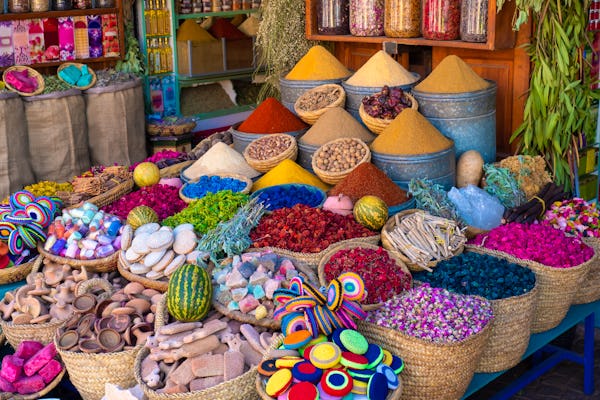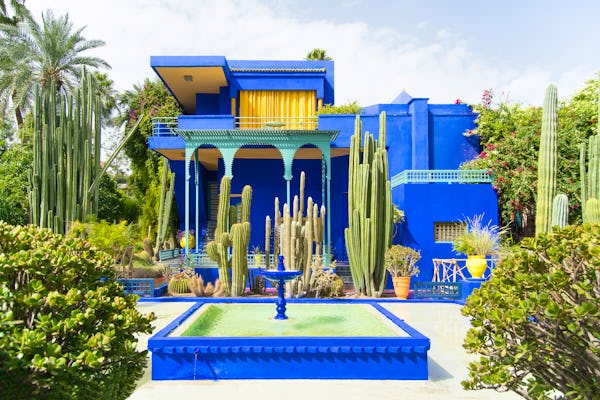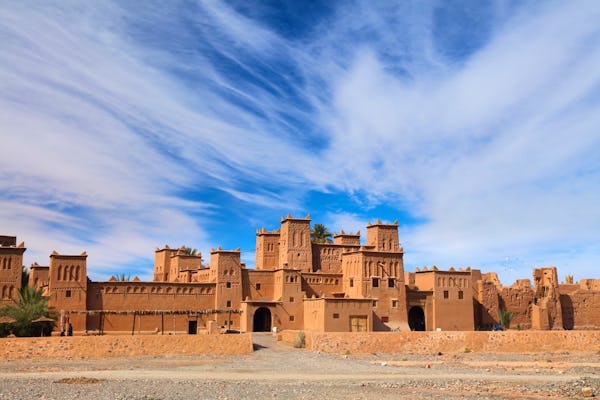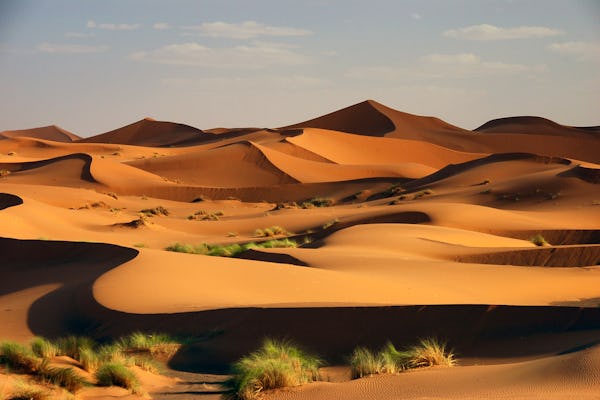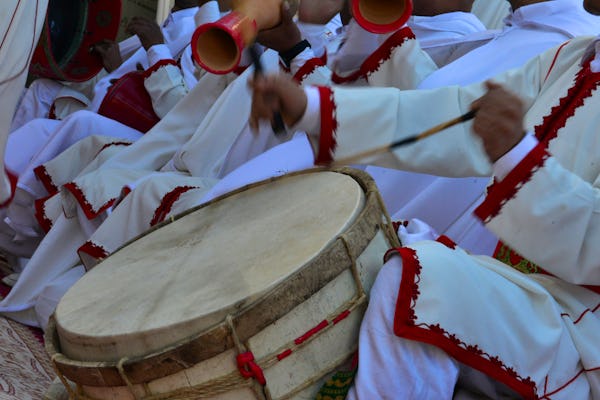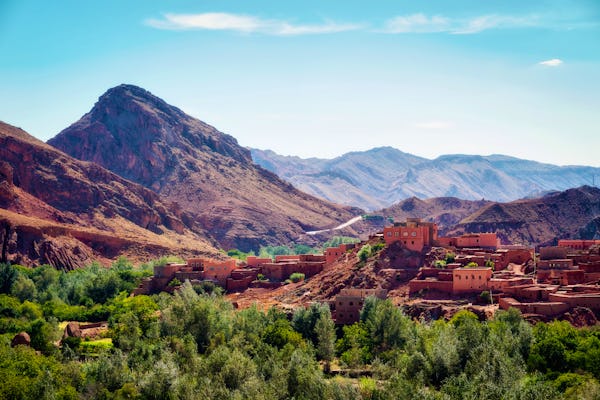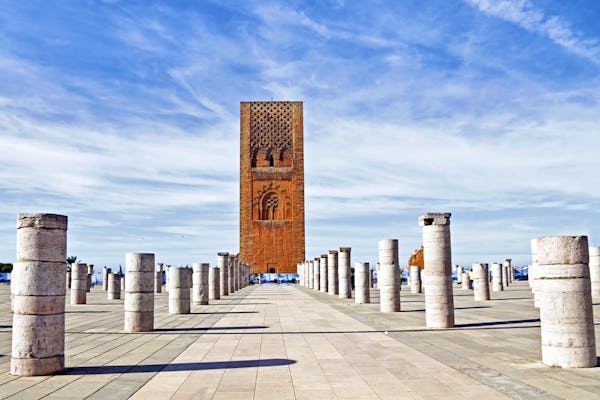Textiles of Morocco
Discover the highlights of Morocco, the indigenous Amazigh/Berber culture and extraordinary textile traditions on this fascinating tour. We’ll visit women’s cooperatives that combine age-old skills with new innovations. In Marrakesh we'll enjoy the exquisite Yves Saint Laurent museum featuring his fashion designs as well as the Berber Museum that houses the Moroccan textiles and jewellery that inspired his work. Following the ancient trade routes across the High Atlas Mountains to the Sahara we find weavers of carpet and cloth and traditional embroiderers in these remote locations, where they still employ their skills and maintain their traditional lifestyle. Add to this the Imperial city of Fez, the ‘blue city’ of Chefchaouen and the capital Rabat. The tour includes hands-on experiences and demonstrations with local artisans as well as hand-sewing workshops with our accompanying textile expert.
Your Tour Includes
- Return flights from London to Marrakesh with 1 piece of hold luggage
- Travel by air conditioned coach
- 14-nights bed and breakfast accommodation
- 7 dinners and 4 lunches
- Entrance fees to cultural sites
- Eco-dyeing workshop
- Traditional craft demonstrations
- Hand-sewing workshops with our expert
- English-speaking Amazigh/Berber guide
- Experienced local Tour Manager
Itinerary
Please choose your preferred 15 day itinerary
Meet our expert at the airport for your flight to Marrakesh. Marrakesh is the fourth largest city in the Kingdom of Morocco. The region has been inhabited by Berber farmers since Neolithic times, but the city itself was founded in 1070 as one of Morocco’s four imperial cities. The red walls of the city, along with numerous buildings constructed in red sandstone in the 1100s have given the city the nickname ‘the red city’. Today Marrakesh is one of the busiest cities in Africa. The medina quarter (old city) is a UNESCO World Heritage Site. We will be met by our local Tour Manager and transfer to our Riad in the Old Medina for dinner and overnight.
Includes Dinner
This morning’s walking tour of the medina takes us to the Tishkiwin Museum, the National Carpet and Weaving Museum as well as some of the souks (traditional markets). Housed in a riad and founded by a Dutch anthropologist, the Tishikwin Museum takes us on a journey across the Sahara, from Marrakesh to Timbuktu, with artifacts exhibited from each caravan stop along this trading route. Collections include carpets, textiles, baskets, clothing and jewellery. Housed in a 19th century palace, the National Carpet and Weaving Museum promotes the rich heritage of Moroccan and Berber carpets and weaving. The museum houses pieces from all regions of Morocco, including urban carpets from Rabat and Casablanca with rich floral decoration and rural carpets from the High Atlas Mountains and Marrakesh. After some free time for lunch in the Medina we’ll visit an embroidery association for disabled women, a handcraft co-operative that focuses on sharing embroidery skills and providing women with a means to earn an independent income as well as improving their literacy. Hand-sewing workshop with our expert at the hotel.
Includes Breakfast
The Majorelle Garden is a 2.5-acre botanical garden and villa complex created by French Orientalist artist Jacques Majorelle over almost 40 years, starting in 1923. Following his divorce in the 1950s Jacques Majorelle was forced to sell the house and land, after which it was neglected and fell into disrepair. In the 1980s it was purchased and restored by fashion designers Yves Saint Laurent and Pierre Bergé. We’ll visit the private collection of Yves Saint Laurent at the Berber Museum including costumes, jewellery and textiles that inspired his life and work as well as the Yves Saint Laurent Museum, a showcase of his fashion and jewellery design. Hand-sewing workshop with our expert at the hotel.
Includes Breakfast
Today we travel to Ait Ben Haddou across the High Atlas pass of Tizi-n-Tichka and along the picturesque Ounila Valley, originally the main thoroughfare of the trans-Saharan trade route between Marrakesh and sub-Saharan Africa. On route we’ll visit the Argan Oil Cooperative where we’ll learn about its history, how it’s grown and traditionally made. Dinner is included this evening.
Includes Breakfast
Includes Dinner
The UNESCO World Heritage Site of Ait Ben Haddou is an impressive Ksar (fortified village). It is considered a great example of Moroccan earthen clay architecture and has been the backdrop to many famous films including Gladiator, Jesus of Nazareth and Game of Thrones. After our guided tour here, we’ll visit a carpet co-operative to see weavers at work and view a range of traditional Amazigh (Berber) carpets. We continue to a village in the Anti-Atlas Mountains where we visit a women’s textile association. We’ll see a demonstration of natural dyeing techniques using rose madder and pomegranate and do some dyeing of our own using silk we have prepared ahead of time. Whilst we are here, we’ll enjoy a traditional couscous lunch prepared by the women. After lunch we’ll relax on the terrace as we work some more on our fabric scrolls. Dinner is included at our guesthouse this evening.
Includes Breakfast
Includes Lunch
Includes Dinner
Our excursion today takes us to the nearby Skoura Oasis. During our short walk through the oasis gardens, we’ll learn about rural community life and subsistence farming before visiting the local pottery for tea and a demonstration by traditional artisans. We continue to a women’s textile co-operative to view the local crafts of weaving, tapestry, embroidery and beading. Lunch at a local guesthouse is included today. From the terrace which overlooks the oasis we’ll be able to enjoy the panoramic views of the High Atlas and Anti Atlas Mountains. Dinner is included this evening.
Includes Breakfast
Includes Lunch
Includes Dinner
Today we travel to Merzouga via the M’Goun Valley (Valley of the Roses) and Valley of 1000 Kasbahs. No one is sure how roses first came the M’Goun Valley. According to legend, they were carried here by a Berber merchant from Damascus; the species that grows here is Rosa damascena, the Damask rose, which originates from ancient Syria and has been celebrated for centuries for its intense perfume. Every year during the main growing season between April and mid-May, the valley produces between 3000 and 4000 tonnes of wild roses. Each day before dawn, women gather the roses by hand and sell them to co-operatives dotted along the valley. Some are bought by local distilleries to make rose water, soaps and potpourri, but the majority are bought by big French perfume houses, for whom the M’Goun roses command a special cachet. The Oasis Museum at Tinjdad housed inside the Ksar El Khorbat, traces tribal migrations through carefully curated items of seminomadic life covering topics such as handicraft, pottery and traditional costume. We’ll spend some time here before visiting a women’s embroidery association where they make the traditional shawls that are worn in the Sahara. 380 million years ago what is now the Moroccan Sahara was the floor of a large prehistoric ocean. After the retreating of the sea fossils of fish, plants and other marine animals formed here and were well preserved thanks to the lack of tectonic activity and the high temperatures. The village of Erfoud is famous for its beautiful fossils. We’ll visit the fossil museum and a shop that produces a range of items made from the local black marble which is often embedded with ancient fossils. Dinner is included this evening.
Includes Breakfast
Includes Lunch
Includes Dinner
Merzouga is a small village close to Erg Chebbi, one of Morocco’s several large seas of dunes formed by wind-blown sand. In places, the dunes of Erg Chebbi rise up to 150 meters from the surrounding rocky desert. Altogether it spans an area of 28 kilometres from north to south and up to 7 kilometres from east to west. We’ll wake up early to enjoy the sunrise in the desert before another short hand-sewing workshop with our expert. The rest of the morning is yours to do as you wish. A lunch of Medfouna (Berber calzone) is included today before we take a short drive to the village of Khamila to see a traditional Gnawa music performance. For centuries black Africans from the Gnawa tribe, originating from sub-Saharan countries such as The Sudan, Mali and Niger, were forcibly moved from their homelands across the Sahara to Morocco as part of the worldwide slave trade. Shackled in chains as they crossed the desert, they sang to soothe and found a mindfulness in the rhythmic chanting and clanking of the chains. The in habitants of Khamlia Village are direct descendants of these slaves. Dinner is included this evening.
Includes Breakfast
Includes Dinner
Wake up early to enjoy the sunrise in the desert before another shorthand-sewing workshop. The rest of the morning is yours to relax by the pool or walk in the dunes. A lunch of Medfouna (Berber calzone) is included today before we take a short drive to the village of Khamila to see a traditional Gnawa music performance. For centuries black Africans from the Gnawa tribe, originating from sub-Saharan countries such as The Sudan, Mali, and Niger, were forcibly moved from their homelands across the Sahara to Morocco as part of the worldwide slave trade. Shackled in chains as they crossed the desert, they sang to soothe and found a mindfulness in the rhythmic chanting and clanking of the chains. The inhabitants of Khamlia Village are direct descendants of these slaves. Dinner is included this evening.
Includes Breakfast
Includes Lunch
Today we make the long but spectacular drive to Fez through the incredible landscape of the High Atlas Mountains, Ziz Valley and Middle Atlas Mountains, home of the Barbary apes. Lunch in a traditional family home is included today.
Includes Breakfast
Includes Lunch
Fez is the second largest city in Morocco and forms a crossroads connecting the important cities of the different regions of Morocco, Tangier, Casablanca, Rabat and Marrakesh. The old city is centred around the Fez River and consists of two old Medina quarters which are listed as a World Heritage Site and believed to be one of the world’s largest pedestrian zones. Since the inception of the city, the tanning industry has been operating in the same fashion as it did in the early centuries. Today, the tanning industry in the city is considered one of the main tourist attractions. There are three tanneries in the city, packed with round stone wells filled with dye or white liquids for softening the hides. The leather goods produced in the here are exported around the world. We’ll take a guided tour of the Medina, visit a leather tannery and wander the streets to see the cultural highlights and the artisanal workshops of weavers, dyers, wood and metal workers. The afternoon is free for you to explore the Medina, do some shopping or have a massage or hammam.
Includes Breakfast
Today we drive north to the famous ‘blue city’ of Chefchaouen, so called due to the striking, blue-washed buildings in the old town. There are several beliefs as to why the Chefchaouen’s walls are painted blue, including the Jewish belief that the colour blue represents the sky, heaven and God, the Islamic belief that blue is the colour of happiness and optimism, to help deter mosquitos and to keep buildings cool, to represent the colour of the Mediterranean Sea or the importance of the city’s Ras el-Maa waterfall where citizens get their drinking water.
Includes Breakfast
We’ll spend the day exploring the beautiful ‘blue’ village. Starting at the waterfall and then winding our way back through the narrow streets, back to Uta Hammam square, the heart of the medina. You have a free afternoon to visit the ‘Ensemble Artisanal’ where you can watch talented artisans at work, peer into tiny independent shops and tour the medina's markets. You can also take part in a hand-sewing workshop with our expert at the hotel.
Includes Breakfast
Rabat is the capital city of Morocco and the country’s 7th largest city in terms of population. It is one of the four Imperial cities of Morocco, along with Fez, Marrakesh and Meknes. We’ll have some time to explore the Medina here, along with nearby Oudayas Kasbah, both listed as UNESCO World Heritage Sites. Our farewell dinner at a nearby restaurant is included this evening.
Includes Breakfast
Includes Dinner
Transfer to Marrakesh for our return British Airways flight to London.
Includes Breakfast
Stitchtopia Craft Holidays
Specially designed for knitters, this Stitchtopia knitting holiday is the ideal opportunity to meet like-minded knitters and indulge in your favourite hobby. Our talented knitting expert will be on hand throughout the holiday and host inspirational workshops with a beautifully designed project to get those needles clicking!


